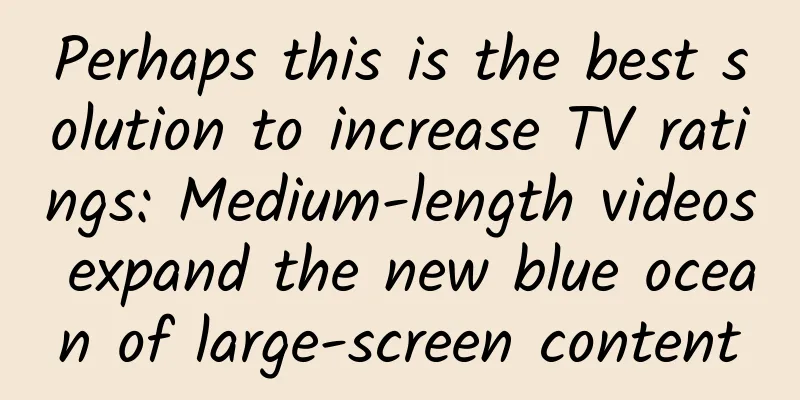Perhaps this is the best solution to increase TV ratings: Medium-length videos expand the new blue ocean of large-screen content

|
For many people born before the millennium, for a long time, the main or even the only form of entertainment was watching TV programs. However, since about 2014, the rapid popularization of mobile phones, computers and other devices has led to an explosive growth in entertainment methods in daily life. Nowadays, the family structure is getting smaller. It is no longer common for a large family to live in one room. Instead, there are more and more small families of two or three people. In big cities, it is not uncommon for multiple strangers to share a room. In this context, TV, a product that can radiate the whole family, has begun to be differentiated into small, independent devices in people's hands. All these factors have caused a great impact on television. In 2019, a research report pointed out that the average daily TV power-on rate has dropped from 70% three years ago to 30%, and people over 40 years old have become the mainstream group watching TV. In 2020, due to the epidemic, the number of domestic TVs turned on finally ended a 10-year decline and showed an upward trend for the first time. According to statistics, during the epidemic last year, the average TV viewing time per household was 7 hours. This wave of television "Renaissance" continues to this day. The epidemic has brought a rare respite to the TV industry, but challenges still exist. This year, sales of smart TVs have fluctuated again due to rising raw material prices and chip shortages, and sales have plummeted - the TV industry has once again begun to endure this roller-coaster market. The significance of mobile phones in the family has been brought back to the table, and the discussion on the co-prosperity of mobile phones and television has once again been brought to the forefront. What can a mobile phone do that a TV can't? Portability and flexibility. What can a TV do that a mobile phone can’t? It is the unparalleled audio and video experience on the big screen and the joyful atmosphere brought by gathering with family and friends. So, from this perspective, mobile phones and televisions actually have their own strengths, and the two are not in an either-or relationship of replacing each other. So why did television seem so miserable in the past few years? In large part, it was because of the massive amount of video content available on mobile phones, computers and other devices. Content remains the secret code for television’s continued success in the future. According to data from the China Internet Information Center, as of December last year, the number of online video users in China reached 927 million, of which 97% chose to watch online video programs on their mobile phones. This not only demonstrates the absolute dominance of mobile phones in the online video industry, but also reflects that the traffic dividend of online video on mobile phones has gradually become saturated. In contrast, the number of users who watch online video programs on TV has reached 47%, which still has great room for growth. Internet video giants have also keenly discovered this trend. Platforms such as iQiyi, Youku, Tencent Video and Mango TV have accelerated the construction of large-screen content in recent years. Taking iQiyi as an example, CEO Gong Yu once said, "The audio-visual experience on Internet TV is better. It is the most important and ultimate terminal for producing high-quality professional content, and it will also be the largest terminal in the future." iQiyi has also launched a series of technical, content and marketing arrangements, and has carried out a number of collaborations with telecom operators and TV manufacturers to enhance the viewing experience on large screens. According to statistics from Aowei Interactive Entertainment, in December last year, the three platforms with the largest number of active TV users were iQiyi, Youku and Tencent, with monthly active terminals exceeding 20 million. This shows that the importance of large screens in the home is gradually moving towards a positive trend. From the perspective of video content, the content resources of these top platforms on TV are concentrated in the field of long videos such as movies, TV shows, and variety shows. However, not all video users are interested in this type of content. The success of UGC video platforms such as Bilibili, Douyin, and Xigua Video has proved one thing from the positive side, that is, users have a very real demand for the richness of the video content ecosystem. Therefore, short videos subsequently became a hot commodity in the large-screen content market. Platforms such as Douyin, Kuaishou, and Xigua have successively entered the large screen, and developers such as TCL Thunderbird and Konka have also directly integrated short videos into the TV system. Short videos can divert traffic to long videos on the large screen by “using short to promote long”, and can also bring business models such as selling goods to the large screen of TV, which brings more possibilities to the large screen. As a form of content, the core competitiveness of short videos is that they allow users to watch them in fragmented time. For most people, watching TV is undoubtedly a more "ritualistic" behavior. Sitting in front of the TV, to a large extent, means that they do not intend to scroll around aimlessly like they do on their computers or mobile phones. Users' concentration on large-screen TVs highlights a potential logic in the video industry: is there another user demand in long and short videos? In fact, when long video resources are concentrated and short videos are incompatible with large screens, medium video content is undoubtedly the most suitable for large-screen TVs. First, large-screen TVs are usually placed in the living room or bedroom, which means that the threshold for use is relatively high and the user's usage time is more complete. Secondly, the TV is displayed in horizontal screen most of the time, and the display effect is also higher-definition and the visual effect is better. From these characteristics, it can be seen that in addition to videos, the content most suitable for the large screen is undoubtedly the "medium video" content with a duration of 1 to 30 minutes, which is created by users in large quantities on platforms such as Bilibili and Xigua Video. In fact, from childhood to adulthood, many of the cartoons, news, and TV programs we have watched on TV are within this time range. It can be said that medium-length videos naturally conform to the viewing habits of large-screen users. As the saying goes, "there are experts among the people." Mid-length videos cover a wide range, and there are many well-made and creative works, which can effectively enrich the video content on large screens. At the same time, mainstream mid-length video platforms already support users to upload 4K resolution videos, so the performance of these videos on large screens will not be inferior at all. Xigua Video is a leading player in this field. Its platform has multiple channels such as automobiles, basketball, and culture, allowing different users to find content that meets their needs. For creators, Xigua Video also has a high subsidy mechanism and regular skills training to help creators produce better content. In August this year, Xigua Video also launched two creation tools, "Video Dehydration" and "Smart Music Extension", to make videos more compact and smooth. In June this year, Xigua Video also fully supported the HDR function, which also made its videos more suitable for presentation on large screens. Xigua Video has also achieved great success on the big screen. According to Xigua Video's official data, as of the second quarter of this year, the consumption time of medium-length videos on TV has reached 35%, which has increased for three consecutive quarters. In the past month, the popular science content of the well-known creator "Teacher Li Yongle" has been viewed on TV for more than 50% of the total playback volume. Xigua Video has grown from a mobile platform, but now the largest audience of some of the top creators on its platform has shifted to the big screen. From this, we can see that medium-length videos have a considerable audience on both large and small screens, and can further form the effect of "small leads the big". It can even be said that medium-length videos are the most versatile video format that can be used on multiple screens today. Xigua Video President Ren Lifeng said that Xigua Video will increase its investment in large-screen platforms in the future. Currently, Xigua Video has launched the "Mid-video Partner Program" in cooperation with Douyin and Toutiao to provide income support to high-quality creators. In the future, the program will also cover multiple screens, and TV traffic will also be included in the revenue sharing, thereby encouraging creators to produce more high-quality videos suitable for large-screen playback. The support of the platform will inevitably usher in a new boom in large-screen mid-video content. Ren Lifeng said that the "middle" in mid-length videos does not simply refer to length or shortness in a physical sense, nor does it refer to a gap, but rather to the most common form of content. Today, with the growth of new channels, mid-length videos are ushering in their own multi-screen era. "The imagination space for mid-length videos goes far beyond mobile phones." According to IDC statistics, by 2022, the number of monthly active users of smart TVs will reach 220 million, and "medium videos" are more in line with the usage habits of large-screen users and have the endless vitality brought by a large number of creators. In addition to long and short videos, medium videos are also opening up new blue oceans for large-screen content. Edited by: Massa As a winner of Toutiao's Qingyun Plan and Baijiahao's Bai+ Plan, the 2019 Baidu Digital Author of the Year, the Baijiahao's Most Popular Author in the Technology Field, the 2019 Sogou Technology and Culture Author, and the 2021 Baijiahao Quarterly Influential Creator, he has won many awards, including the 2013 Sohu Best Industry Media Person, the 2015 China New Media Entrepreneurship Competition Beijing Third Place, the 2015 Guangmang Experience Award, the 2015 China New Media Entrepreneurship Competition Finals Third Place, and the 2018 Baidu Dynamic Annual Powerful Celebrity. |
<<: Microsoft: It is necessary for Xbox One games to be censored in China!
Recommend
Sailing east six times? This is Jianzhen's voyage eastward
Sailing east six times? This is Jianzhen's vo...
WeChat has launched a new feature that can make your photos move
Recently, WeChat has quietly upgraded its "S...
What is superconductivity? Believe me, you will definitely understand it in this article
Superconductivity is a "star" in the ph...
Can the "super-Earth" outside the solar system become our new home?
Produced by: Science Popularization China Author:...
Competitive Product Analysis Report | Where to Go on the Weekend and Lazy Weekend, what are their respective advantages and disadvantages?
As people's income and living standards gradu...
Volvo is caught up in a controversy over counterfeit audio systems, Bowers & Wilkins becomes Bowers & Wilkins fake audio systems, where are the interests of users?
Volvo, which rarely has scandals, has recently be...
Who is the most perfectly evolved creature in the world?
Who is the most perfectly evolved creature in the...
[ASO Practice] No need to brush or spend money, 6 tricks to multiply the real reviews on AppStore!
No matter how the industry spreads that reviews a...
Douyin operation: How to create a popular Douyin account?
Is TikTok still in its bonus period? Douyin has e...
Brazil nuts come from Tibet. Are pecans walnuts? Interesting facts about nuts
Nuts are a favorite snack for most people. Everyo...
How good were ancient people when it came to eating?
One minute with the doctor, the postures are cons...
APP operation and promotion tips: 37 free online promotion channels
The following is a complete guide that will intro...
What kind of copywriting do users like most? 15 secrets to understanding copywriting that impresses users in one article
What kind of copy is more likely to impress users...
Bilibili (B Station) product analysis!
With the continuous integration of new elements, ...
Master this and you can also write high-conversion copy!
If we observe carefully, we will find that now ad...









